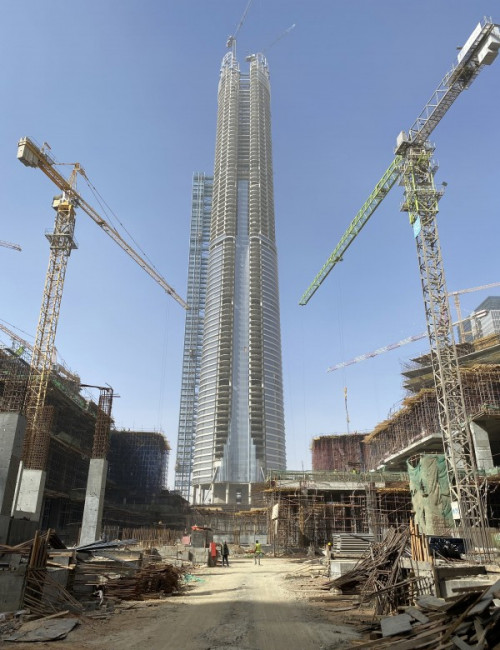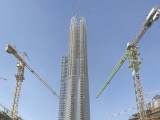Iconic Tower
Cairo
Note: As this project is architecturally topped out, the data is based on the most reliable information currently available. This data is thus subject to change until the building has completed and all information can be confirmed and ratified by the CTBUH.
- Facts
-
Metrics
You must be a CTBUH Member to view this resource.
Official Name
Iconic Tower
Name of Complex
Type
Building
Status
Architecturally Topped Out
Expected Completion
2024
Country
City
Address
Function
A mixed-use tall building contains two or more functions (or uses), where each of the functions occupy a significant proportion of the tower's total space. Support areas such as car parks and mechanical plant space do not constitute mixed-use functions. Functions are denoted on CTBUH "Tallest Building" lists in descending order, e.g., "hotel/office" indicates hotel function above office function.
Hotel / Residential / Office
Structural Material
Both the main vertical/lateral structural elements and the floor spanning systems are constructed from steel. Note that a building of steel construction with a floor system of concrete planks or concrete slab on top of steel beams is still considered an “all-steel” structure as the concrete elements are not acting as the primary structure.
All-Concrete
Both the main vertical/lateral structural elements and the floor spanning systems are constructed from concrete which has been cast in place and utilizes steel reinforcement bars and/or steel reinforced concrete which has been precast as individual components and assembled together on-site.
All-Timber
Both the main vertical/lateral structural elements and the floor spanning systems are constructed from timber. An all-timber structure may include the use of localized non-timber connections between timber elements. Note that a building of timber construction with a floor system of concrete planks or concrete slab on top of timber beams is still considered an “all-timber” structure as the concrete elements are not acting as the primary structure.
Mixed-Structure
Utilizes distinct systems (e.g. all-steel, all-concrete, all-timber), one on top of the other. For example, a Steel Over Concrete indicates an all-steel structural system located on top of an all-concrete structural system, with the opposite true of Concrete Over Steel.
Composite
A combination of materials (e.g. steel, concrete, timber) are used together in the main structural elements. Examples include buildings which utilize: steel columns with a floor system of reinforced concrete beams; a steel frame system with a concrete core; concrete-encased steel columns; concrete-filled steel tubes; etc. Where known, the CTBUH database breaks out the materials used within a composite building’s primary structural elements.
Concrete-Steel Composite
Height
393.8 m / 1,292 ft
Floors Above Ground
77
Floors Below Ground
1
Construction Schedule
Construction Start
Completed
Architect
Usually involved in the front end design, with a "typical" condition being that of a leadership role through either Schematic Design or Design Development, and then a monitoring role through the CD and CA phases.
Usually takes on the balance of the architectural effort not executed by the "Design Architect," typically responsible for the construction documents, conforming to local codes, etc. May often be referred to as "Executive," "Associate," or "Local" Architect, however, for consistency CTBUH uses the term "Architect of Record" exclusively.
Structural Engineer
The Design Engineer is usually involved in the front end design, typically taking the leadership role in the Schematic Design and Design Development, and then a monitoring role through the CD and CA phases.
MEP Engineer
The Design Engineer is usually involved in the front end design, typically taking the leadership role in the Schematic Design and Design Development, and then a monitoring role through the CD and CA phases.
Contractor
The main contractor is the supervisory contractor of all construction work on a project, management of sub-contractors and vendors, etc. May be referred to as "Construction Manager," however, for consistency CTBUH uses the term "Main Contractor" exclusively.
Other Consultant
Other Consultant refers to other organizations which provided significant consultation services for a building project (e.g. wind consultants, environmental consultants, fire and life safety consultants, etc).
Other Consultant refers to other organizations which provided significant consultation services for a building project (e.g. wind consultants, environmental consultants, fire and life safety consultants, etc).
You must be a CTBUH Member to view this resource.
Owner/Developer
Ministry of Housing, Utilities and Urban Communities of Egypt
Architect
Usually involved in the front end design, with a "typical" condition being that of a leadership role through either Schematic Design or Design Development, and then a monitoring role through the CD and CA phases.
Usually takes on the balance of the architectural effort not executed by the "Design Architect," typically responsible for the construction documents, conforming to local codes, etc. May often be referred to as "Executive," "Associate," or "Local" Architect, however, for consistency CTBUH uses the term "Architect of Record" exclusively.
Structural Engineer
The Design Engineer is usually involved in the front end design, typically taking the leadership role in the Schematic Design and Design Development, and then a monitoring role through the CD and CA phases.
MEP Engineer
The Design Engineer is usually involved in the front end design, typically taking the leadership role in the Schematic Design and Design Development, and then a monitoring role through the CD and CA phases.
Contractor
The main contractor is the supervisory contractor of all construction work on a project, management of sub-contractors and vendors, etc. May be referred to as "Construction Manager," however, for consistency CTBUH uses the term "Main Contractor" exclusively.
Other Consultant
Other Consultant refers to other organizations which provided significant consultation services for a building project (e.g. wind consultants, environmental consultants, fire and life safety consultants, etc).
Other Consultant refers to other organizations which provided significant consultation services for a building project (e.g. wind consultants, environmental consultants, fire and life safety consultants, etc).
Research
22 August 2022
Structural Design of Iconic Tower, Egypt: Culmination of a Concrete Optimization Process
Tarek Hassan, Yehia El-Ezaby & Charles Malek, rector Dar Al Handasah Consultants (Shair and Partners)
This paper presents an overview of a process of optimizing concrete mixture for tall buildings, culminating in the design of the Iconic Tower, the key...
Global News
18 July 2022
Concrete Structure Reaches Completion for Tower in Egypt’s New Administrative Capital, Cairo
The Iconic Tower in Egypt’s New Administrative Capital (NAC) completed construction of the concrete structure and finishing touches are now underway. It is one of...
Global News
18 July 2022
Concrete Structure Reaches Completion for Tower in Egypt’s New Administrative Capital, Cairo
The Iconic Tower in Egypt’s New Administrative Capital (NAC) completed construction of the concrete structure and finishing touches are now underway. It is one of...
23 July 2021
Tower in Egypt’s New Administrative Capital Tops Out
The Iconic Tower in Egypt’s New Administrative Capital (NAC) completed construction of the concrete structure. It is one of 18 skyscrapers planned for NAC’s Central...

18 January 2021
First Tower in Egypt's New Capital District Near Cairo Complete
The first office tower in Egypt's New Administrative Capital (NAC) has been completed, according to China State Construction Engineering Corporation (CSCEC). The C08 building, which...

17 March 2020
First Skyscraper Capped in Egypt’s New Administrative Capital
China State Construction Engineering Corporation (CSCEC) has finished the capping of the first skyscraper in the 20-tower business district that it is building in Egypt's...
21 January 2019
Construction Begins on Iconic Tower
The foundations for what could become Africa’s tallest building, a 385-meter-tall tower in Egypt’s new administrative capital, will be poured within days, according to the...
Subscribe below to receive periodic updates from CTBUH on the latest Tall Building and Urban news and CTBUH initiatives, including our monthly newsletter. Fields with a red asterisk (*) next to them are required.
View our privacy policy






